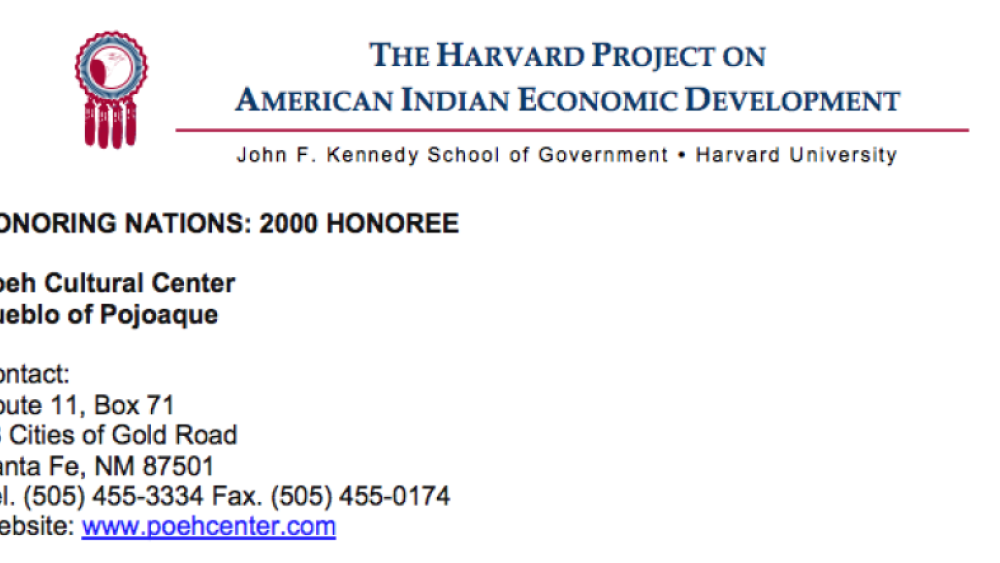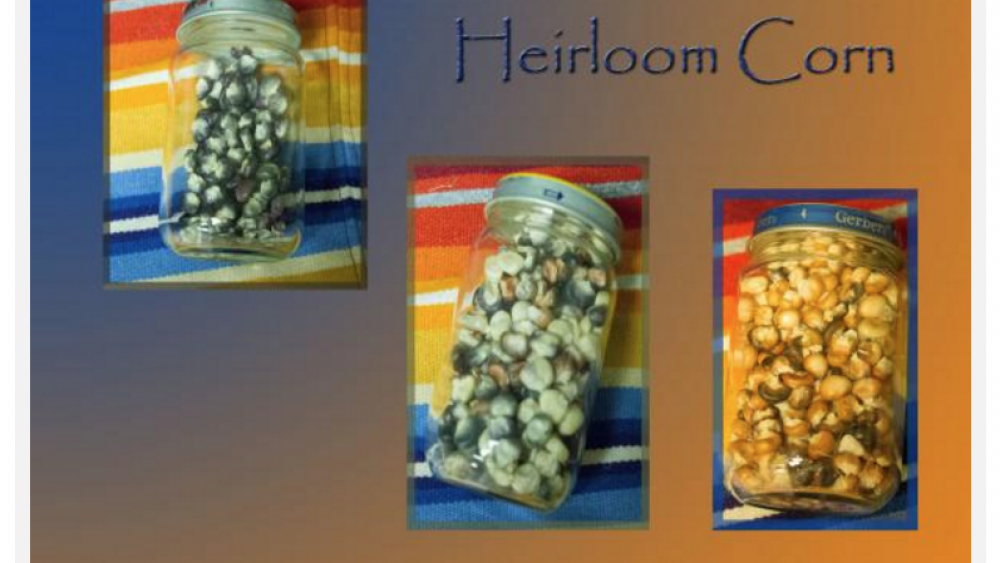Lori Gutierrez shares Pojoaque Pueblo's journey of cultural preservation and revitalization, and its keys to using culture as a resource in the establishment of the Poeh Cultural Center and Museum.
Additional Information
Gutierrez, Lori. "Using Culture as a Resource: Poeh Center." Honoring Nations symposium. Harvard Project on American Indian Economic Development, John F. Kennedy School of Government, Harvard University. Sante Fe, New Mexico. February 7, 2002. Presentation.
Transcript
Andrew Lee:
"Now I'd like to turn this over to the next theme, which is 'Using Culture as a Resource.' Again, one of the themes that comes through the Honoring Nations winners is that they're able to tap into the culture and use it as a resource for making advances, whether it's in the cultural or whether it's economic, social, health, right across all the areas of... almost all the Honoring Nations winners have some component of culture to them. Today we have with us Lori Gutierrez, who's with the Pojoaque Pueblo Construction Services Corporation. They won an award last year...in 2000, they won an award for their Poeh Cultural Center, which is an incredible place and in fact we'll be...many of us will be going out there on Saturday to visit the Poeh Center. I'll let Lori speak to what they've actually done. But let me just say that it's an incredible place of cultural revitalization, preservation, and economic development that's taking place under Lori's watch. Welcome, Lori."
Lori Gutierrez:
"Good afternoon. My name is Lori Gutierrez and I am Assistant Director for Pojoaque Pueblo Construction Service Corporation. And to my discussion, I extend my apologies for George Rivera who is Lieutenant Governor and Executive Director of the Poeh Center. He was unable to make this presentation today. Our discussion is about 'Using Culture as a Resource.'
Currently, Pojoaque Pueblo is in a state of revitalization. The revitalization process of today is merely one chapter in a long process of the Pojoaque's cultural development. In order to express our values that we hold so dearly to us today, it is important to gain insight to what has brought us to this point. Archaeological studies indicate that in the late 1500s and early 1600s, Pojoaque Pueblo had a large population, and since the early Spanish settlements of the early 1600s, Pojoaque has struggled to maintain its culture. Twice in its history the village was left abandoned. In 1699, due to Spanish colonization, the pueblo was deserted. In 1864, a plea was made to claim title to the original land grant of the 13,000 acres. The pueblo and its inhabitants were again devastated by a small pox epidemic, lack of water, and encroaching non-Indians, which forced many to move away. By 1912, the last known tribal member, who was acting as governor, left the reservation for outside employment. In 1934, the Commission of the Indian Affairs issued a call asking for all tribal members to return to the reservation. In 1946, the pueblo became a federally recognized tribe. Each time the Pueblo people came back, change was inevitable, but strengthened by their resolve, the tribe has overcome adversity and has adjusted to many changes. In just the past 30 years, we have seen many firsts. In 1973, Pojoaque Pueblo danced traditional dances for the first time in over 100 years. In 1972, Pojoaque Pueblo elected its first female governor. In 1988, a tribal resolution was adopted to develop the Poeh Culture Center and Museum. And in 1992, the Pueblo began construction of its kiva or a ceremonial place. It was the first time in over 100 years. And just recently, two months ago, on December 12th of 2001, Pojoaque dancers were led by Pojoaque tribal members as drummers and singers. Prior to this, Pojoaque had graciously accepted the help of neighboring tribes.
The harshness Pojoaque has faced and endured has allowed the tribe to place a priority on its culture revitalization. The vehicle for this re-emergence is the Poeh Center and Museum. The Poeh Center and Museum is more than a museum. It is a learning center for both the functional and traditional arts. 'Poeh,' in Tewa, means 'the road' or 'path,' the path taken through life. In other words, the Poeh is the philosophy of life. The mission statement of Poeh is, 'It is the goal of the Poeh Center to create a place for the people of northern Pueblos to recreate their traditional ties to the Tewa culture and belief and to express these through art.'
The Poeh Center serves as a national model for cultural revitalization, as well as intertribal cooperation. The Poeh Center is currently still under construction, but has approximately 26,000 square feet complete. The space is used for administration and office space as well as studio space. Once complete, the Poeh Center facility will be a permanent home for the art collection, as well as be an exhibit area, and its museum will promote the greater understanding of the Tewa tribes.
As I noted, there was functional and traditional arts. The functional arts include Tewa classes, our traditional language, weaving, hide tanning, moccasin, basket and drum making classes. Permanent traditional arts include pottery, jewelry, sculpture, as well as business and business development courses. Classes are offered to all Native Americans and the original scope of work was for Native Americans in northern New Mexico, however, that has since expanded. The tribes of Jicarilla Apache, Navajo, Acoma, Sioux, Cherokee, to name a few, are represented in its current student register. The classes offered by the Poeh Center are certified by the U.S. Department of Education, as well as the Poeh Center Vocational Education Program is accredited by the University of New Mexico and Northern Mexico Community College. Starting in 1994, the Poeh Arts Program had in excess of 200 artisans complete the two-year program. Currently, 87 individuals are enrolled at the Poeh Center. An additional training program has begun at the Pojoaque Pueblo Boys and Girls youth program where they have in excess of 200 children. In addition to just being an introduction to Native American arts, the program is also cooperating with an anti-drug project.
The Pueblo of Pojoaque's emergence as a developing tribe begins a new chapter with the Poeh Center. It is this resource that the tribe leans on for its strength, culture development, and learning. As a developing tribe, Pojoaque has paid close attention to ensuring its future. Extensive infrastructure and planning have gone into all aspects of economic and social projects. The creation of the Poeh Center is the infrastructure of the Pueblo's culture vitalization and continuity. As noted by Andrew, we did receive the award last year. Our project was the unique collaboration between the company I work for, which is Pojoaque Pueblo Construction Services Corporation, and the Poeh Center.
As I noted previously, the Poeh Center was established in 1988. At that time, the tribe had a very small economic base. We had a grocery store and a hardware store and we had a small 13,000 acres. So it was limited as to what our resources were. And when the tribe embarked on this large project to build the Poeh Center, how to sustain this project was a key issue. So using an innovative project they developed and incorporated Pojoaque Pueblo Construction Services Corporation. The corporation, which first would build the Poeh Center project, which is a multi-phase project, at cost, secondly, it would do more off the reservation where revenues from the profit center would go back to build the Poeh Center facility. And in ensuring that, not only will it build the Poeh Center, but it also will help keep and maintain the projects that it has for them right now. In conclusion, we are so very proud of our accomplishments, our survival and our future."



